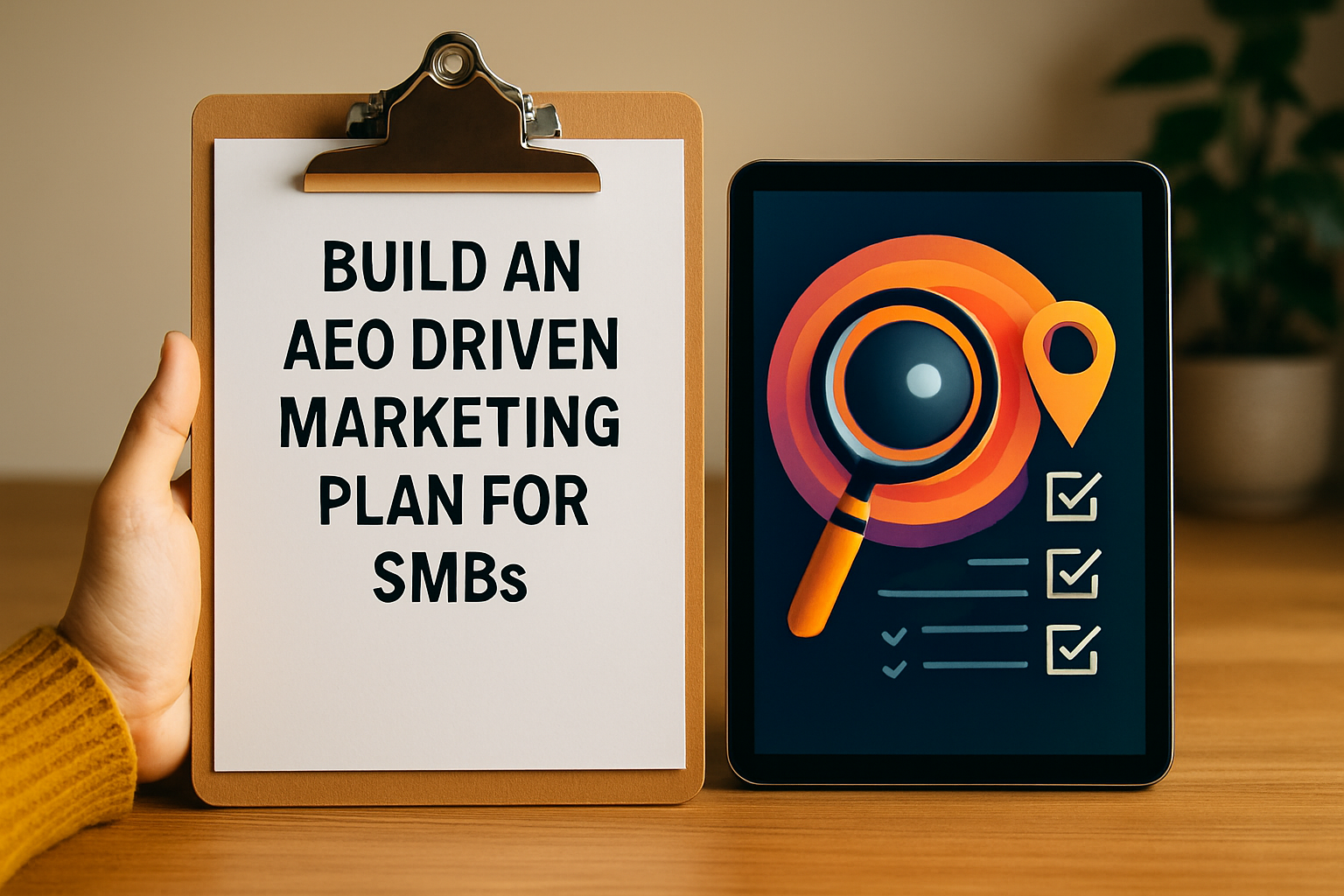7-Step Lead Conversion Checklist for Small Businesses

Did you know that businesses using advanced lead management strategies see up to 50 percent higher conversion rates than those who do not? Attracting and converting leads is more than just marketing. It is about building trust with every click and conversation. From smart forms to instant review requests, every detail shapes how prospects become loyal customers. Mastering these proven tactics can help you connect faster, qualify leads smarter, and nurture each relationship for maximum success.
Table of Contents
- 1. Capture Leads Efficiently With Smart Forms
- 2. Qualify Leads With Automated Screening
- 3. Respond Quickly Using AI-Powered Chat Agents
- 4. Nurture Prospects With Personalized Email Sequences
- 5. Schedule Calls Instantly With Calendar Integration
- 6. Build Trust Through Instant Review Requests
- 7. Track And Optimize Each Stage Of Conversion
Quick Summary
| Takeaway | Explanation |
|---|---|
| 1. Use smart forms for lead capture | Minimize input fields and adapt based on user responses to create a seamless experience. |
| 2. Automate lead qualification for efficiency | Establish clear criteria to focus on high-intent leads and improve sales efficiency. |
| 3. Implement AI chat agents for instant engagement | Use AI bots to provide immediate customer communication, answering queries while you focus on other tasks. |
| 4. Personalize email sequences to nurture leads | Craft targeted email campaigns based on user behavior to build meaningful connections and guide prospects. |
| 5. Integrate calendars for seamless scheduling | Enable self-scheduling options that minimize back-and-forth communications, making it easier for prospects to book appointments. |
1. Capture Leads Efficiently with Smart Forms
Capturing leads is more than collecting contact information. It is about creating a smooth experience that turns interested visitors into potential customers.
According to the Small Business Administration, digital forms are critical for modern businesses. Smart forms represent a strategic approach to reducing friction during lead capture by intelligently adapting to user responses. The goal is simple: make providing information as easy and painless as possible.
Key Design Principles for Smart Forms:
- Minimize required input fields
- Adapt dynamically based on user responses
- Create a mobile friendly interface
- Provide clear value proposition
Research from the National Institute of Standards and Technology reveals that progressive disclosure techniques can dramatically improve form completion rates. By showing only relevant fields and breaking complex forms into smaller steps, businesses can reduce user overwhelm and increase conversion potential.
Practically speaking, this means designing forms that feel like a conversation rather than an interrogation. Start with essential questions. Ask for minimal information upfront. Use dropdown menus, multiple choice options, and autofill features to streamline data entry. Your form should feel intuitive and respectful of the user’s time.
Pro tip: Include a clear value proposition near your form explaining exactly what benefit users receive by submitting their information. Whether it is a free guide, consultation, or exclusive content, make the exchange feel worthwhile.
Implementing smart forms can transform your lead generation from a passive process to an engaging interaction that welcomes potential customers into your business ecosystem.
2. Qualify Leads with Automated Screening
Not all leads are created equal. Automated lead screening helps you focus your energy on prospects most likely to become paying customers.
According to the Small Business Administration, implementing rule-based lead qualification workflows can dramatically improve sales efficiency. By establishing clear screening criteria, businesses can automatically filter and prioritize high-intent leads before any human interaction occurs.
Strategic Lead Qualification Factors:
- Budget compatibility
- Projected timeline
- Specific business needs
- Geographic relevance
- Decision making authority
Research from the National Institute of Standards and Technology emphasizes the importance of predefined screening criteria. Automated systems can quickly assess whether a potential lead meets your basic business thresholds, saving valuable time and resources.
In practice, this means creating a scoring system that assigns points to leads based on specific attributes. For example, a lead might score higher if they have a budget matching your service range, an immediate need, and decision making power within their organization.
Important screening questions might include understanding a prospect’s budget range, project urgency, current challenges, and potential for long-term collaboration. By automating this initial assessment, you transform lead generation from a time consuming manual process into an intelligent, efficient workflow.
The goal is not to eliminate leads but to prioritize and personalize your engagement strategy. Automated screening allows you to direct your most personalized attention to leads with the highest potential return on investment.
3. Respond Quickly Using AI-Powered Chat Agents
In the digital age, potential customers expect instant communication. AI-powered chat agents offer small businesses a powerful tool to provide immediate engagement without overwhelming their team.
Why Speed Matters in Lead Conversion:
- 80% of customers expect real-time responses
- Immediate engagement increases conversion probability
- 24/7 availability expands business reach
- Reduces human response time lag
AI chat agents act like digital receptionists who never sleep. They can handle multiple conversations simultaneously, answer frequently asked questions, collect preliminary lead information, and even schedule initial consultations without human intervention.
The magic of AI chat agents lies in their ability to provide personalized interactions at scale. Unlike traditional chatbots that offer rigid scripted responses, modern AI agents can understand context, interpret nuanced questions, and provide intelligent answers tailored to each visitor’s specific inquiry.
Implementing an AI chat agent allows your business to create an always-on communication channel. Imagine converting website visitors into potential leads while you are sleeping, attending meetings, or focusing on other critical business tasks. These intelligent systems can qualify leads, answer basic questions, and seamlessly transition complex inquiries to human team members.
Practical implementation starts with choosing an AI chat solution that integrates smoothly with your existing systems. Look for platforms offering natural language processing, customizable conversation flows, and robust analytics to track interaction quality and lead generation performance.
Remember that the goal is not to replace human interaction but to enhance and accelerate your initial customer engagement. AI chat agents serve as your front-line communication strategy creating a responsive, welcoming digital environment that turns casual website visitors into interested prospects.
4. Nurture Prospects with Personalized Email Sequences
Email marketing is not about sending mass messages. It is about creating intelligent conversations that guide potential customers through their buying journey.
According to the Small Business Administration, strategic email drip campaigns can transform casual leads into committed customers by delivering targeted content at precisely the right moment.
Key Components of Effective Email Sequences:
- Segmented audience targeting
- Behavior triggered content
- Progressive value delivery
- Personalized messaging
- Clear conversion pathways
Academic research highlights that personalization dramatically improves engagement. By crafting email sequences that adapt to individual user behaviors and interests, businesses can create a more meaningful connection.
In practice, this means designing email workflows that respond dynamically to how a prospect interacts with your content. Someone who downloads a guide about social media marketing might receive a different sequence compared to someone interested in website design.
Your email sequence should feel like a helpful conversation. Start with introducing your expertise. Share valuable insights. Address potential challenges your prospects might face. Gradually build trust by demonstrating understanding of their specific needs.
Technically sophisticated email sequences can track user interactions. Did they click a specific link? Open a particular email? These micro signals help you understand their interests and refine your approach.
The ultimate goal is transforming email from a broadcast tool into a precision instrument for building relationships. When done right, personalized email sequences can turn cold leads into warm prospects eager to learn more about your business.
5. Schedule Calls Instantly with Calendar Integration
Eliminating scheduling ping pong is crucial for converting leads into customers. Integrated calendar tools transform the consultation booking process from a frustrating experience into a seamless interaction.
According to the Small Business Administration, self scheduling options dramatically improve lead engagement by removing traditional communication barriers. Prospects want convenience and instant gratification when exploring potential business services.
Strategic Calendar Integration Benefits:
- Reduce scheduling back and forth
- Provide 24/7 booking availability
- Sync across multiple team calendars
- Minimize scheduling conflicts
- Decrease administrative overhead
Research from the National Institute of Standards and Technology underscores the importance of secure real time scheduling systems that intelligently manage staff availability and reduce potential no show rates.
Practically speaking, calendar integration means creating a user friendly booking experience where potential clients can see your actual availability and select time slots that work for both parties. Advanced systems can automatically send confirmation emails, sync with your primary calendar, and even include reminder notifications.
The best calendar tools do more than just display available times. They should integrate smoothly with your existing workflow, automatically block out personal time, manage different meeting types, and provide buffer periods between appointments.
Think of calendar integration as your digital receptionist working around the clock. It eliminates endless email exchanges, provides crystal clear availability, and signals to potential clients that your business values their time and convenience. By making scheduling effortless, you increase the likelihood of turning interested prospects into actual meetings.
6. Build Trust Through Instant Review Requests
In the digital marketplace, customer reviews are your most powerful marketing weapon. Instant review requests transform satisfied clients into vocal brand ambassadors.
According to the Small Business Administration, timely review solicitation is critical for building social proof and credibility. The moment a customer experiences your service is precisely when their enthusiasm and willingness to share feedback peaks.
Strategic Review Request Elements:
- Immediate post service timing
- Simple submission process
- Multiple platform options
- Personalized request approach
- Clear value of sharing feedback
Research from the National Institute of Standards and Technology recommends automating review invitations through SMS or email channels immediately following customer interactions. This approach capitalizes on real time emotional engagement and increases likelihood of response.
Practically implementing review requests means creating a seamless workflow that feels natural to your customers. Design short, straightforward review links that can be clicked within seconds. Make providing feedback feel like a quick favor rather than a time consuming task.
The psychology of review requests matters. Customers want to know their opinion counts. Frame your request as an opportunity to help other potential clients make informed decisions. Express genuine appreciation for their time and feedback.
By systematically collecting and displaying authentic customer experiences, you transform scattered individual testimonials into a powerful trust building mechanism. Potential leads see real stories from people just like them making your business more approachable and credible.
7. Track and Optimize Each Stage of Conversion
Converting leads is not a one time event. It is a carefully choreographed journey that requires constant measurement and strategic refinement.
According to the Small Business Administration, understanding your conversion pipeline means tracking leads through distinct stages from initial capture to final purchase. This granular approach allows businesses to identify precisely where potential customers might lose interest.
Critical Conversion Tracking Metrics:
- Lead capture rate
- Qualification percentage
- Response time
- Engagement duration
- Conversion rate
- Customer acquisition cost
Research from the National Institute of Standards and Technology emphasizes implementing comprehensive metrics at each conversion stage. The goal is not just measurement but continuous optimization of your sales process.
Think of your conversion funnel like a complex machine. Each stage represents a potential point of friction where leads might slip away. By monitoring specific metrics you can diagnose bottlenecks and implement targeted improvements.
Practically speaking, this means creating a dashboard that tracks lead progression transparently. Which marketing channels produce the most qualified leads? Where do prospects typically disengage? What intervention strategies increase conversion likelihood?
Successful businesses treat lead conversion as a science not an art. They experiment constantly testing different approaches measuring results and iteratively improving their systems. Your conversion tracking should provide clear actionable insights that help you understand exactly how to turn more interested prospects into paying customers.
Below is a comprehensive table summarizing the lead generation strategies discussed throughout the article.
| Strategy | Implementation | Expected Results |
|---|---|---|
| Smart Forms | Minimize fields; adapt based on responses; mobile-friendly; use progressive disclosure techniques. | Smooth user experience; improved form completion rates; higher conversion potential. |
| Automated Lead Screening | Implement rule-based criteria; score leads on attributes like budget and timeline. | Focus on high-intent leads; increased sales efficiency. |
| AI-Powered Chat Agents | Use AI to handle FAQs, schedule consultations; provide real-time personalized interactions. | Instant customer engagement; 24/7 availability; reduced human response time. |
| Personalized Email Sequences | Segment audience; trigger content by behavior; deliver progressive value; track engagement. | Build meaningful connections; higher engagement; guide leads through the buying journey. |
| Calendar Integration | Offer self-scheduling; sync across calendars; manage availability and send reminders. | Reduced scheduling friction; improved lead engagement; more successful consultation bookings. |
| Instant Review Requests | Automate requests post-service; use SMS/email; offer simple submission process. | Build social proof; increased customer trust and credibility. |
| Track and Optimize Conversion | Monitor metrics like lead capture rate and response time; use dashboards to track progress. | Identify bottlenecks; continuous improvement of the sales process; better customer acquisition results. |
Simplify Your 7-Step Lead Conversion Process with Authority Echo
Struggling to turn leads into loyal customers while managing the complex steps of capture, qualification, and nurturing? The article highlights common pain points like slow lead responses, complicated scheduling, and inefficient follow-ups that can stall your sales growth. Authority Echo is designed to solve these exact challenges by automating key tasks including smart lead capture, AI-powered chat agents for instant responses, personalized email sequences for nurturing, and real-time calendar integration to book calls without hassle.

Take control of your lead conversion journey today with a unified platform built for small businesses. Experience faster lead qualification, seamless appointment scheduling, and effortless review management all from one dashboard. Visit Authority Echo and discover how easy growing your business can be. Don’t let opportunities slip away any longer start optimizing your lead conversion strategy now at https://authorityecho.com.
Frequently Asked Questions
What is the purpose of a 7-step lead conversion checklist for small businesses?
The purpose of a 7-step lead conversion checklist is to streamline the process of turning interested visitors into paying customers. Follow each step methodically to enhance your lead capture, qualification, and engagement strategies, potentially increasing your conversion rate by over 15%.
How can I effectively capture leads with smart forms?
To effectively capture leads with smart forms, minimize the number of required input fields and make the form mobile-friendly. Start by asking for essential information only, adopting user-friendly features like dropdowns and autofill to improve the completion rate.
What are the key components of automated lead screening?
Key components of automated lead screening include defining clear criteria such as budget relevance and decision-making authority. Create a scoring system to prioritize leads, allowing you to focus on the most promising prospects and increase your sales efficiency by 30%.
How do I create personalized email sequences for nurturing leads?
To create personalized email sequences, segment your audience based on their interactions and interests, and deliver targeted content accordingly. Design email workflows that guide leads through their buying journey, ensuring a conversation-like tone that can improve engagement significantly.
Why is instant calendar integration important for scheduling calls?
Instant calendar integration is crucial for reducing scheduling back-and-forth communication. Implement a self-scheduling tool to allow prospects to book calls based on your availability, increasing appointment setting by approximately 40% and enhancing client convenience.
How can I effectively track and optimize each stage of lead conversion?
To track and optimize each stage of lead conversion, establish key metrics like lead capture rates and conversion rates. Regularly analyze these metrics to identify bottlenecks and implement targeted improvements, leading to more efficient lead management and increased sales outcomes.




